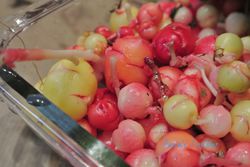 With our oca young plants (Oxalis tuberosa) we offer a new, but nevertheless also old vegetable plant. The colourful tubers enrich our diets not only in terms of appearance, but also the taste of these vibrant tubers has a lot to offer. Oca has always been cultivated for its bright-coloured, edible tubers. However, both the leaves and the shoots can also be eaten. In this article, you will learn how this vegetable from the highlands of South America can enrich our gardens and our diet in many ways – and how you can supplement your vegetable assortment with this exciting and versatile tuber fruit.
With our oca young plants (Oxalis tuberosa) we offer a new, but nevertheless also old vegetable plant. The colourful tubers enrich our diets not only in terms of appearance, but also the taste of these vibrant tubers has a lot to offer. Oca has always been cultivated for its bright-coloured, edible tubers. However, both the leaves and the shoots can also be eaten. In this article, you will learn how this vegetable from the highlands of South America can enrich our gardens and our diet in many ways – and how you can supplement your vegetable assortment with this exciting and versatile tuber fruit.
Where does oca come from?
As mentioned, oca (Oxalis tuberosa), an underground stem tuber from the wood sorrel family, originates from South America, better said from the high altitudes of the Andes regions. Here the tubers were already cultivated by the Incas in addition to potatoes and various other tuberous fruits and they are still very popular there today.
Growing oca in Europe
In Europe, oca tubers are mainly grown as an annual crop. The herbaceous shoots die back with the first heavier night frosts in autumn, and the tubers can tolerate only about -5°C in the ground, perhaps a little less. Only in extremely mild wine-growing regions or in the British Isles is it possible to grow oca as a perennial. However, this cultivation variant is at the expense of the tuber size and yield.
When planting, a rather semi-shaded location should be chosen since the plants completely stop growing during prolonged periods of heat and when subject to direct sun. Therefore, planting as early as possible, after the risk of late frost has passed, is also recommended. In this way, the plant can still develop as much as possible in late spring and early summer – and thus the foundation is laid for the largest possible tuber set.
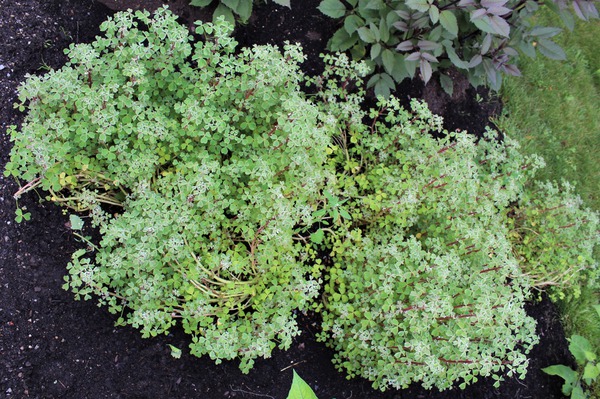
Picture: strongly grown oca plants in the garden
Oca belongs to the photoperiodic plants and thus the tubers are formed only from mid-September, or rather when the day length is less than 12 hours. Therefore, patience must also be shown during harvesting because the plants ideally need about six weeks to form the tubers. That is, the harvest should take place no earlier than the end of October.
To increase the yield, it makes perfect sense to cover the centre of the oca plants with a few shovels of soil in August. This measure will produce more roots and, consequently, more tubers. It also makes sense to protect the plants from the first night frosts in October so that the tubers get as much time as possible to grow and mature.
Oca – an entirely edible plant
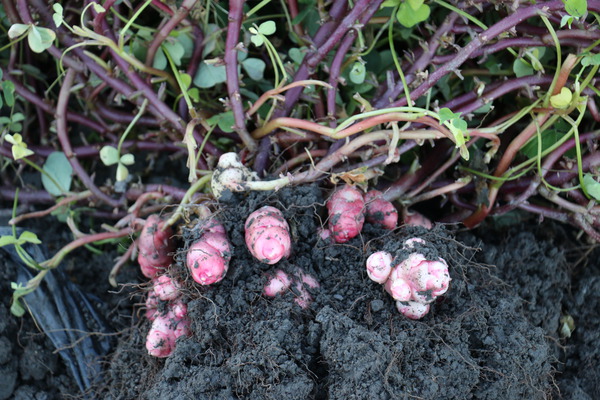
Picture: digged out oca plant; tubers, shoots and leafes are edible
In short, all parts of the oca plants (leaves, shoots and tubers) can be eaten. The leaves, like the flowers, are used in salads and provide a lemony, sour freshness. However, flowering is rather rare in our region, partly because in domestication the emphasis of human selection was placed on tubers (and propagation by tubers), but also because the flowering also depends on the short day photoperiod. The shoots, up to 40 cm long, can be used like rhubarb, with the difference that they can also be eaten raw.
Likewise, the tubers can also be eaten raw, for example as a snack with a dip. They can also be boiled, baked, roasted or fried.
Oca is known as the New Zealand yam, though it is not a true yam and was introduced to Europe as a competitor to the potato. The leaves and shoots are mainly eaten raw and have a fresh, sour flavour that is reminiscent of rhubarb. Needless to say, Oxalis tuberosa – as the Latin name suggests – contains a certain amount of oxalic acid, however this has no negative effects as long as the fresh shoots and leaves are only used as flavouring additives and are not eaten in large amounts.
But the focus is on the tubers, which can be enjoyed raw and cooked, as already mentioned. They also have that fresh, tart but also slightly earthy flavour. When cooked, some of the acidity (as well as the bright colour of the skins) is lost, and the taste as well as the texture is then more reminiscent of a (very aromatic) fruity potato, so to speak.
One of the best methods of preparation is making oca chips. For this, the tubers are cut lengthwise into thin slices (please do not peel), lightly brushed with olive oil and baked on a baking sheet in the oven until they are golden yellow and crispy. This method of preparation then also partially preserves the attractive colour of the peel.
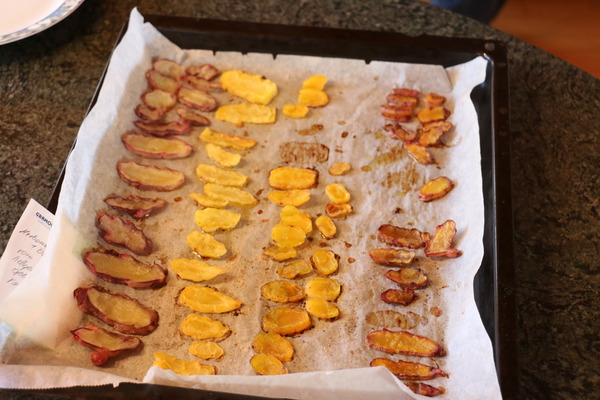
Picture: oca crisps ready to eat
The advantages for the consumer
As a plant producer and/or trader or seller, besides the producibility and the own added value of a crop, the advantages for the end consumer should always play an important role. Below we have compiled the most relevant advantages for the hobby gardener:
- Oca are ideal plants for a semi-shaded or even shaded location, apart from areas with temperate summer climates, most notably maritime-influenced areas such as northern Germany, the Netherlands or the British Isles
- In locations with temperate summer climates, oca can be planted even late (until early August)
- All parts of the plant are edible (flowers, leaves, shoots and tubers) and the colourful tubers have many uses. They can be eaten fresh, boiled or fried
- Up to now, there are almost no known diseases in oca plants in Europe
The most important cultivation tips for the hobby gardener and end consumer
To ultimately ensure a good yield of oca plants, we have summarised the most important cultivation tips for you.
- It is better to choose a semi-shaded or even fully shaded location than a location in full sun
- Fertilise the oca plants, if at all, only at the start of cultivation, ideally directly at the time of planting
- Cover the shoots with soil in the second half of August to get more roots and thus more tubers
- Be patient and harvest late; the later you harvest the more and the bigger tubers will be formed
- Protect your oca plants with a fleece in autumn when the first night frosts occur. As long as the plants are green and active, the tubers will grow
- Easy storage of the tubers: in the dark at 4-15°C until spring. In the light, especially the light-coloured tubers turn slightly green, but these greenish tubers, unlike potatoes, are still edible and not poisonous. Just after harvesting, it makes sense to leave the tubers at higher temperatures for a while because then additional sugar is formed, which makes the taste even more attractive
Oca – the shade vegetable: a must for every retail vegetable assortment
In addition to the benefits for the end consumer, our oca young plants also allow producers and retailers a certain unique selling proposition in the field of vegetable plants. This is because vegetables in particular should be thought of in terms of assortments rather than individual varieties. Together with the other crops from our vegetable group 'Fruits of the Roots®' such as yacon, Jerusalem artichoke or also sweet potatoes, we offer our customers an extensive and exceptional assortment of tuber vegetables, which can also be produced easily, smoothly and quickly. Oca has the additional advantage of growing best where other plants fail: in the shade. In every garden there are certainly several places (and perhaps every year in other places) where there is still a free space in the shade or partial shade, which for lack of suitable plants has remained unattended and unworked until now. In addition, the clover-like leaves and shoots of the oca plants are also very attractive visually.
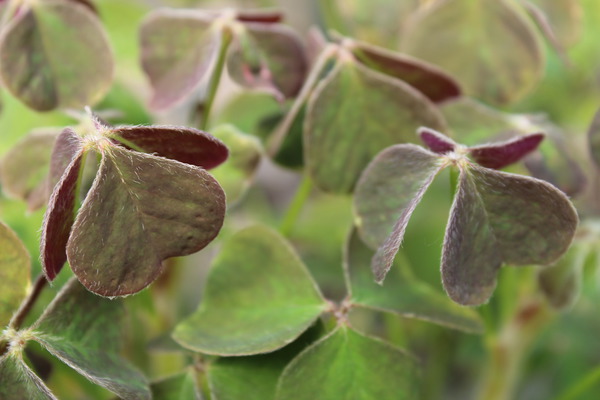
Picture: not only edible but also beautiful to look at, the clover-like leaves of the oca
Due to the described growth characteristics (shade, short day and cooler locations), oca plants are also perfect for permaculture or mixed plantings: for example, rows or single plants (of the tall plants) of sweet corn or yacon can be planted alternately with oca.
More articles about oca
If we have now sparked your interest about this exciting as well as colourful tuber vegetable, then read the next article about oca right away. On the one hand about our offered oca young plant quality with a schematic representation on how you can produce oca plants. And on the other hand our interesting article about our current assortment of oca young plants. In this article we also give you an insight into the oca breeding programme at Lubera® and how our assortment will develop in the future.
